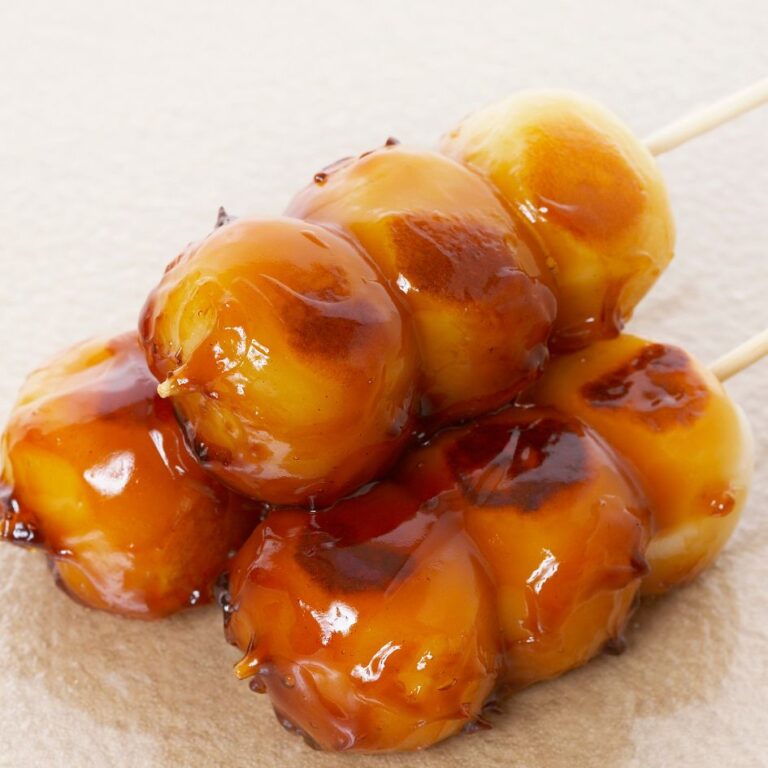
Dango

Japanese Dango: Sweet Rice Dumplings That Steal the Show
If you’ve ever strolled through a vibrant Japanese festival or wandered the streets of Japan, chances are you’ve encountered Dango, the sweet and chewy rice dumplings that have captured the hearts of locals and tourists alike.
Served on a skewer and often coated in a variety of sauces or glazes, Dango is a traditional Japanese street food with a unique texture and flavour that keeps people coming back for more. Here we will explore the history of Dango, its cultural significance, the varieties you can try, and where to find this iconic snack.

What Is Dango?
Dango is a Japanese snack made from rice flour and water, rolled into small balls, skewered, and either grilled or steamed. It’s typically enjoyed with a topping or glaze that ranges from sweet to savoury, making it a versatile dish suitable for all taste preferences.
Dango is a popular street food, especially during festivals and seasonal events, and its bite-sized portions make it perfect for eating on the go.
The History and Cultural Significance of Dango
Dango has been enjoyed in Japan for centuries, with its origins tracing back to the Heian period (.794–1185). It became a common offering at temples and shrines, symbolizing good fortune and blessings. Over time, Dango evolved into a beloved street food and dessert, served in different variations to suit the changing seasons.
For example:
- Hanami Dango is enjoyed during cherry blossom season, with its three colors—pink, white, and green—symbolizing spring’s beauty.
- Tsukimi Dango is eaten during autumn’s moon-viewing festivals, symbolizing gratitude for the harvest.
Varieties of Dango You’ll Love
Dango comes in many forms, each offering a unique taste and experience:
- Mitarashi Dango: Glazed with a sweet soy sauce, it offers a perfect balance of salty and sweet flavours.
- Anko Dango: Topped with smooth or chunky red bean paste for a traditional Japanese dessert taste.
- Hanami Dango: A colourful version served during spring festivals, with mild sweetness in each bite.
- Kinako Dango: Coated in roasted soybean flour for a nutty, earthy flavour.
- Goma Dango: Covered in black sesame seeds or paste, offering a rich, nutty taste.
Why Dango Is a Street Food Favourite
- Portable and Convenient: Skewered for easy handling, Dango is perfect for snacking while walking through markets or festivals.
- Versatile Flavours: Sweet or savoury, you can find a Dango variety to suit your cravings.
- Cultural Experience: Eating Dango is a way to connect with Japanese traditions and seasonal celebrations.
- Chewy and Satisfying: Its unique texture is both fun to eat and filling, making it a go-to snack for all ages.
Where to Find Dango
Dango is widely available in Japan and even in Japanese communities abroad:
- Street Food Markets: Look for stalls at festivals or popular street food areas.
- Temples and Shrines: Vendors often sell freshly made Dango near cultural sites.
- Dessert Shops: Specialty stores offer artisanal Dango with creative toppings.
- Make It at Home: With simple ingredients, you can recreate Dango in your own kitchen.
Why You Should Try Dango
Dango is more than just a snack—it’s a delicious representation of Japanese culture and tradition. From its chewy texture to its rich flavours, it’s a treat that will leave a lasting impression. Whether you’re exploring a Japanese street market or enjoying a quiet afternoon at home, Dango is a sweet and satisfying way to experience Japan’s culinary heritage.
.
We may receive compensation from partners listed through affiliate partnerships, at no cost to you. This doesn’t influence our ratings, and the opinions are our own
QUICK LINKS
- Blogs
- Privacy Policy
Join our Newsletter
Get the latest recipes, trends and travel ideas
